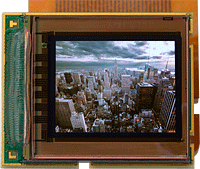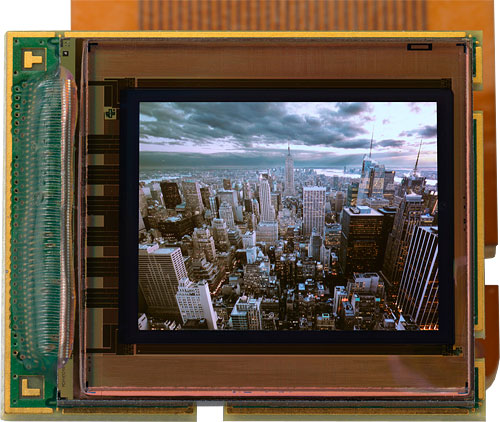New EVF makes it clear: the optical viewfinder’s days are numbered
posted Friday, January 27, 2012 at 2:29 PM EST
 For years, pundits and industry leaders alike have predicted the end of the optical viewfinder, but enthusiast and pro photographers have stubbornly clung to them for their benefits over electronic viewfinders. Today, a new microdisplay from French company MicroOLED S.A.S. promises to take a big step towards erasing those advantages.
For years, pundits and industry leaders alike have predicted the end of the optical viewfinder, but enthusiast and pro photographers have stubbornly clung to them for their benefits over electronic viewfinders. Today, a new microdisplay from French company MicroOLED S.A.S. promises to take a big step towards erasing those advantages.
MicroOLED's latest microdisplay model has a resolution of over five million square dots, with a dot pitch of 4.7 microns, and is said to have no gaps between pixels. That's an astoundingly high resolution -- it's more than double that of Sony's XGA (1,024 x 768 pixel) OLED panel, which we've seen in the NEX-7, SLT-A77 and SLT-A65, as well as the FDA-EV1S viewfinder accessory that's available for the NEX-5N. We were already impressed with the resolution of Sony's EVF, which offer a very sharp image that makes for very easy manual focusing, even without zooming in on the live view feed. With double that resolution, the new MicroOLED microdisplay has likely surpassed the limits of the human eye, in terms of resolution at least.
Do note, though, that the press release refers to pixels rather than dots. We think this is likely because the display is also offered in a monochrome version, which has a total resolution of 2,560 x 2,048 greyscale pixels, with a 5:4 aspect ratio. For the full 24-bit color version, capable of displaying around 16 million unique colors, resolution is stated as SXGA. That's 1,280 x 1,024 pixels, suggesting a four-dot-per-pixel design, likely RGBW. (There's also a slight inconsistency between the claimed 5.4 million dot resolution, and the 5.24 million dots implied by the array resolution.)
An RGBW array would probably explain the extremely high contrast ratio of 100,000:1, an impressive ten times the range of Sony's OLED display. This should help MicroOLED's display answer one of the remaining criticisms of electronic viewfinders, namely that their dynamic range is too narrow to show the nuances of the contrasty, real-world scenes most photographers are accustomed to shooting in.
Other desirable attributes of the MicroOLED display include low power draw of 0.2 watts, and 96 percent uniformity.
Of course, the comparison to Sony's OLED viewfinders is hardly fair. MicroOLED is said to be targeting uses such as professional cameras and camcorders, the defense and medical industries (night vision and head-mounted displays), etc. By contrast, Sony's display is already affordable enough to appear in cameras that are affordable to enthusiast photographers. We draw the parallels only because Sony's display has by far the highest resolution we've yet seen in cameras available at retail. These technologies have a way of trickling down surprisingly quickly, though, and that leaves us with the distinct impression that the clock is ticking for the optical viewfinder...
|
MicroOLED's new microdisplay has a resolution of around 1.3 megapixels in color, or five megapixels in black and white. Photo provided by MicroOLED SAS. |
Press Release
MicroOLED introduces highest pixel density OLED microdisplay
MicroOLED's new 5.4 mega pixel 0.61 inch diagonal microdisplay gives users SXGA resolution in full color at half the power consumption of competing products
Grenoble, France, January 27, 2012-MicroOLED, a maker of highly power-efficient superior image quality microdisplays for near-to-eye applications, today introduced a new 5.4 million pixel density 0.61 inch diagonal, low power consumption OLED (Organic Light-Emitting Display) microdisplay on silicon for applications demanding high picture quality, such as professional camera and camcorder equipment, night vision systems and head-mounted displays used in surgery.
The ultra-compact 5.4 million-pixel microdisplay with a sub-pixel pitch of 4.7 micrometres by 4.7 micrometres is the highest pixel density OLED microdisplay available today. By doubling the pixel density of comparable products, MicroOLED has eliminated the gap between pixels. With no black matrix present, the resulting image resolution is of the highest quality. This makes the 5.4 million-pixel 0.61 inch diagonal microdisplay most suitable for defense, medical and professional camera applications that demand sharp images with very smooth transitional tones.
High contrast (maximum 100,000:1) and high uniformity (96 per cent) also play key roles in picture quality. Depending on how one drives the OLED microdisplay, it can perform using as low as 0.2W, half the power consumption of other products in its category. MicroOLED achieves this low level power consumption even when the fully digital video input is embedded.
"We are really excited by the market potential of our new 5.4 million pixel density 0.61 inch diagonal OLED microdisplay that is superior in picture quality to any product in its category," said Eric Marcellin-Dibon, CEO of MicroOLED. "This OLED microdisplay is already creating quite a stir among world leaders in imaging products who commend the high pixel density and the remarkable image quality. Moreover, the current trend in replacing optics with electronics components fits excellently with our ability to produce this exceptional picture quality in miniature format. We see many opportunities opening up in existing applications and new markets as a result."
MicroOLED will market the 5.4 million-pixel density 0.61 inch diagonal microdisplay to address needs in three areas: head-mounted displays used by surgeons, where high resolution and quality of colors and contrast are a must; professional camera and camcorders, where picture quality is key; and night vision applications, where heightened contrast and uniformity enable defense and security professionals to improve the performance of detection and identification equipment.
The 5.4 million-pixel density microdisplay comes in full color (16 million colors), SXGA or monochrome formats (2,560 by 2,048 pixels), both with digital video input. It meets the standard environmental operating requirements for military applications. The new product builds on MicroOLED's exclusive OLED patent technology that is recognized for its ability to eliminate defects common in other microdisplays, such as color non-uniformity or fixed pattern noise.
About MicroOLED
MicroOLED makes highly power-efficient microdisplays with superior image quality for mobile near-to-eye viewing devices used by consumers, medical professionals, and the defense and security industry. Through its microdisplays, MicroOLED makes it easier to integrate high definition in camera viewfinders, 3D goggles, head-mounted displays and other visual devices. The company's exclusive high efficiency OLED (organic light-emitting diode) technology license provides significant advantages in high efficiency, contrast, uniformity and image sharpness making its microdisplays superior in quality to the full High Definition image in today's flat screens. MicroOLED's products also benefit from very low power consumption.
Founded in 2007, MicroOLED is a privately held company with headquarters, R&D and a new 300,000-unit production facility located in Grenoble, a renowned center of excellence in France for chipset and nanotechnology development. The company is led by a management team highly experienced in advanced technologies, including several years' research & development in OLED technology from CEA-LETI, a leading European micro-and nanotechnology research center.
